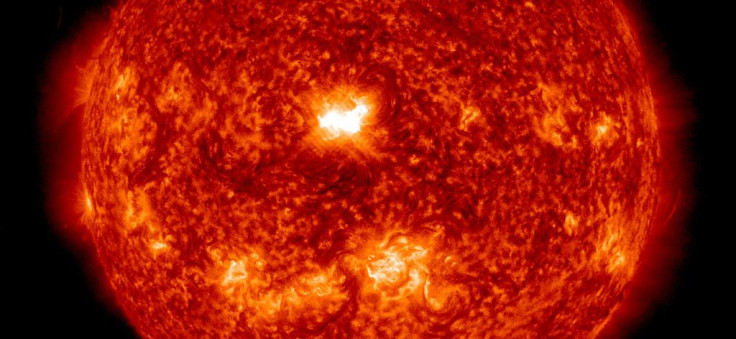Solar Flare Live Stream: Where And When To Watch ‘Amazing’ Solar Event Online [VIDEO]

The sun shot off two large solar flares this week, sending clouds of superheated solar plasma tearing through space at millions of miles per hour -- and its aim was spot on. One of the flares is headed straight for Earth, and while scientists say it doesn't pose a serious threat to our planet, it will certainly put on an impressive show. A live stream of the solar flare, slated for Thursday at 1 p.m. EDT, will provide a view of the cosmic event like no other.
The solar flares originated from a region of the sun known as Active Region 2158, according to NASA. The first flare, a medium-strength flare, occurred Tuesday and was followed by an X-class flare -- the most powerful type -- on Wednesday. It typically takes the charged particles a few days to make their way to Earth.
The live feed is hosted by Slooh, a robotic telescope service that offers live feeds of various events in space via its website. The service has telescopes all over the world, including Spain, Chile and the U.S. Thursday’s show comes directly from the observatory in Prescott, Arizona. Scientists will provide live commentary during the solar flare webcast, which begins at 1 p.m. EDT. Send questions to astronomers during the live stream via Twitter using the hashtag #Sloohflare.
Slooh to cover X1.6 class solar flare with LIVE views on Thursday! #Sloohflare Watch on http://t.co/PJCHT97iWv pic.twitter.com/u8EaIqO3hA
— SLOOH (@Slooh) September 10, 2014What exactly is a solar flare? A solar flare is a violent burst of high-energy radiation that gets ejected from the sun’s surface. It occurs when magnetic energy that has built up in the solar atmosphere suddenly pops with an intensity equal to tens of millions of hydrogen bombs.
Some solar flares are stronger than others. X-class flares, like the one that occurred Wednesday, are among the most violent and can produce auroras on Earth and expose airline passengers flying over the poles to small doses of radiation, according to NASA. NASA captured two X-class solar flare bursts in June, but neither was directed at Earth.
In the event that a strong solar flare directly hits our planet, it could cause major disruptions of Earth’s power grid and disrupt satellite and radio transmissions. Scientists have long predicted that a massive solar flare with the potential to cause catastrophic blackouts is coming, as was the case on Sept. 1, 1859, when a solar storm bombarded Earth with invisible waves of charged particles and caused electric currents to surge through telegraph lines, knocking out service at several stations.
“Operators of today’s communication systems and power grids would be less sanguine,” Timothy Ferris of National Geographic noted in 2012. “No solar superstorm as powerful as the 1859 event has occurred since, so it is difficult to calculate what impact a comparable storm might have on today’s more wired world.”
In 1989, a solar superstorm one-third less intense than the 1859 storm knocked out the power grid in Quebec, Canada, which served more than six million customers. The National Academy of Sciences estimated that a solar flare the size of the 1859 one, if it happened today, could result in economic losses equal to 20 Katrina-class hurricanes, according to National Geographic.
"What solar experts fear most is a recurrence of the huge coronal mass ejection events of 1921 and 1859," Slooh astronomer Bob Berman said in a statement. Scientists estimate that such a solar event would inflict a whopping $1 trillion to $2 trillion dollars’ worth of damage and take more than a year to repair, Berman added. "So it’s more than of mere academic interest to monitor and observe these violent events as they unfold,” he said. “Plus, they're amazing to watch."
© Copyright IBTimes 2024. All rights reserved.






















